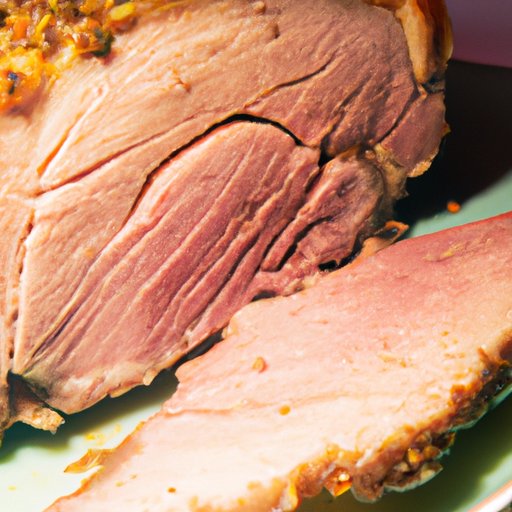
Introduction
If you’re looking to impress dinner guests or just want to enjoy a mouthwatering meal at home, look no further than roast beef. While this dish may seem intimidating to cook, we’re here to break it down for you step-by-step. In this beginner-friendly guide, we’ll cover everything you need to know about selecting the right cut of meat, prepping and seasoning, cooking, carving, pairing, and even the nutritional benefits. With this guide, you’ll be cooking a mouthwatering roast beef in no time.
Step-by-Step Guide
Selecting the Right Cut of Meat
The most important step in cooking a delicious roast beef is selecting the right cut of meat. Look for a cut that has marbling, which will help keep the meat tender and juicy during cooking. Some popular cuts for roast beef include ribeye, sirloin, and tenderloin. Decide what you prefer based on your budget and taste preferences.
Prepping the Meat
Before cooking, make sure to bring your meat to room temperature. This will help the beef cook more evenly. Take the meat out of the fridge an hour or two before cooking and let it sit covered on the kitchen counter. Additionally, trim away any large pockets of fat.
Seasoning
The beauty of roast beef is its simplicity. All you really need is salt and pepper. Make sure to season the beef on all sides before cooking. Other seasoning options can include garlic, rosemary, or thyme.
Cooking
The key to delicious roast beef is slow cooking. Preheat your oven to 350 degrees Fahrenheit. Place the roast in a roasting pan and bake for 18 to 20 minutes per pound. Use a meat thermometer to check for your desired level of doneness: 120-130°F for rare, 130-135°F for medium-rare, 135-145°F for medium, and 145-155°F for medium-well. Once cooked to your liking, let the beef rest for 10-15 minutes before carving.
Carving the Roast
When carving, make sure to cut against the grain. This will help keep the meat tender. Aim for thin, even slices.
Recipe Format
List of Ingredients
- 1 (4-5 lbs.) beef roast
- 1 tablespoon kosher salt
- 1 tablespoon freshly ground black pepper
Clear and Concise Instructions
- Preheat oven to 350°F.
- Season the beef with salt and pepper.
- Place the roast in a roasting pan and bake for 18 to 20 minutes per pound, or until it reaches the desired internal temperature.
- Let the beef rest for 10-15 minutes before carving.
Cooking Technique
Slow cooking is the best technique when it comes to making roast beef. You can either roast it in the oven or grill it. Regardless of the method you choose, make sure to cook the beef low and slow. This will help keep it juicy and tender. If roasting, use a meat thermometer to check the internal temperature to avoid over or under-cooking.
Tips and Tricks for Each Technique
– When roasting, consider using a marinade to impart extra flavor.
– When grilling, sear the roast first and then move it to a cooler part of the grill to finish cooking slowly.
– For both methods, it’s crucial to let the beef rest after cooking to help keep it juicy.
Pairing Ideas
Suggestions for Side Dishes
Roast beef pairs well with a variety of side dishes. Some suggested options include roasted vegetables, mashed potatoes, or a side salad. Experiment until you find your perfect combination.
Wine Pairing Recommendations
When it comes to wine pairing, a full-bodied red wine such as Cabernet Sauvignon or Merlot will complement the rich flavors of the roast beef perfectly.
Nutritional Benefits
In addition to being delicious, roast beef provides some essential nutrients. It’s high in protein and contains B-vitamins, iron, and zinc. To choose a healthier cut of meat, look for beef labeled as “lean” or “extra lean”. Additionally, select a cooking method that doesn’t require a lot of added oils or fats.
Suggestions for Healthier Cooking Methods
– Avoid deep-frying or cooking with added fats.
– Consider using a slow-cooker or pressure cooker for a low-fat cooking method.
Conclusion
Cooking a delicious roast beef may seem daunting, but with this guide, you’ll be an expert in no time. By selecting the right cut of meat, seasoning, and slow cooking, you can make a mouthwatering roast beef that will impress your dinner guests or provide a tasty meal for yourself. Make sure to experiment with different side dishes and wine pairings until you find your perfect combination. Finally, by highlighting the nutritional benefits and providing suggestions for healthier cooking methods, we hope to inspire you to make roast beef a regular fixture on your dinner menu.





